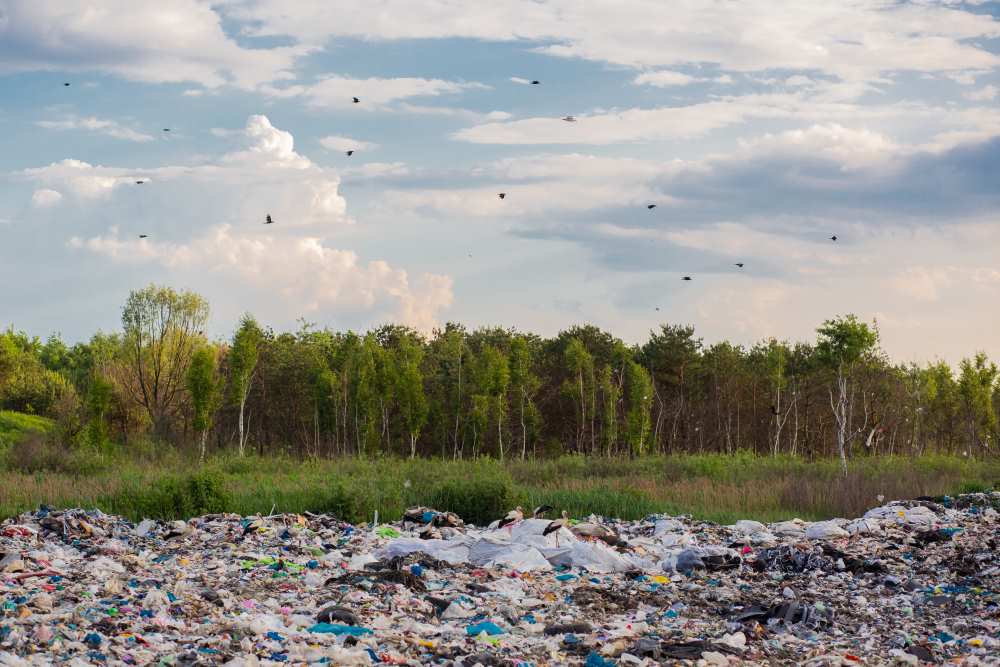9 Malicious Diseases Caused by Land & Soil Pollution

Land pollution or soil contamination is the degradation and deterioration of the earth’s crust due to the abnormal and excessive concentration of toxic substances. The diseases caused by land pollution are jeopardising human health more and more each day. As a result, it has =become one of the most important environmental concerns in recent times.
Read through to know about the wrath of land pollution on human health!

Table of Contents

What are Land Pollution Diseases?
Diseases caused by people's exposure to contaminated soil are known as land pollution. Such ailments are commonly caused by toxic chemicals, heavy metals, insecticides, and other poisonous substances that get into the soil through diverse ways, such as industrial waste, agricultural activities, and poor garbage removal.
Humans may develop different health conditions when they touch or consume contaminated soil, including breathing difficulties, skin issues, nervous system impairments, and cancer, and due to long-term exposure to toxic chemical substances such as heavy metals, pesticides, and industrial wastes.
What Are the Causes of Land Pollution Diseases?

The major causes of soil-related diseases are human activities that introduce pollutants into the soil and, subsequently, the environment. These include:
- Manufacturing units and industries, for example, commonly release toxic chemicals, such as waste from heavy metals, leading to land pollution.
- Herbicides, fertilisers, and pesticides can accumulate harmful substances in the ground. Some of these may find their way into groundwater, causing health problems.
- Garbage sites where domestic or industrial wastes are dumped without any prior treatment. This may leach toxic constituents that poison soil pollution.
- Mining is often linked to the extraction and processing of minerals. This leads to soil erosion, heavy metal contamination, and ecosystem destruction.
- Deforestation or clearing vegetation for urban growth or farming can create a situation where the earth’s uppermost layer is infertile, making it susceptible to contaminants.
- Urbanisation involves converting natural lands into cities, which leads to cumulative volumes of construction waste, among other things, in soils.
These actions disrupt the normal equilibrium on the earth's surface, resulting in diseases associated with land pollution.
9 Diseases Caused By Land and Soil Pollution in Humans
Land pollution offers a broad spectrum of threats to plants, animals and human health. The pollutants alter the soil composition, creating an unhealthy soil environment that leads to multiple infectious diseases.
Contaminants present in soil result in long term diseases like -
1. Cancer

Lung cancer can result from inhaling asbestos over a long time. Asbestos is a common soil contaminant. Inhaled asbestos reaches lungs, accumulating in the lung tissue for a long time which causes severe ailments like lung carcinoma, parenchymal asbestosis and pleural mesothelioma. Furthermore, dioxins are also responsible for contracting cancer.
2. Arsenicosis

Consuming arsenic for a long time results in chronic arsenic poisoning. Excess intake of arsenic also leads to gastrointestinal tract, liver, heart damage.
Drinking impure water is the primary source of arsenic. In addition, chronic exposure to it results in skin lesions like hyperpigmentation, keratosis etc.
3. Skeletal Fluorosis

Skeletal Fluorosis is a disease caused by land pollution. Fluoride present in the soil accumulates in the bone over a long time. Early symptoms include pain and stiffness in the joint. Crippling skeletal fluorosis includes osteosclerosis, calcification of tendons and ligaments and other bone deformities.
4. Kidney and Liver Damage

Presence of heavy metals like cadmium that reaches the human food chain causes kidney and liver damage. It also results in low bone density.
Cadmium ruptures the kidneys, resulting in excessive production of protein in urination. Consuming mercury also leads to liver and kidney damage and affects the central nervous system and our gastric system.
5. Neurological Disorders

Exposure to lead, a common soil contaminant, can lead to neurological disorders. In children, lead poisoning affects cognitive development and can result in learning disabilities and behavioural issues. In adults, it can cause peripheral neuropathy, characterised by numbness, tingling, and muscle weakness.
6. Respiratory Diseases

Soil polluted with particulate matter and volatile organic compounds (VOCs) can worsen asthma and cause chronic obstructive pulmonary disease (COPD). Fine particulate matter (PM2.5) can settle into the lungs, causing inflammation. Long-term exposure can lead to chronic respiratory diseases, resulting in persistent coughing, wheezing, or shortness of breath.
7. Gastrointestinal Issues

Contaminated soils with pathogens and heavy metals can cause gastrointestinal issues upon consumption. This leads to chronic diarrhoea, dysentery, and other digestive disorders from waterborne or foodborne pollutants. They can also cause swelling and damage to gut walls. Repeated exposure may result in serious gastrointestinal illnesses, including cirrhosis.
8. Immune System Disorders

Heavy metal pollutants weaken the immune system, raising susceptibility to infections by bacteria and viruses. Prolonged exposure can cause autoimmune disorders, affecting organs like the liver and kidneys. This compromised immunity leads to frequent infections and makes individuals more prone to illness compared to those with healthy immune systems.
9. Reproductive Health Issues

Pollutants such as pesticides and heavy metals can adversely affect reproductive health. Heavy metals can disrupt hormonal balance and reproductive function. Furthermore, contaminants like dioxin and arsenic are toxic and carcinogenic, leading to reproductive and developmental damage. Developing foetuses are vulnerable to dioxin exposure and are highly affected by it.
The presence of lead in the soil affects the nervous system, specifically that of children.
In addition to these, there are several short-term effects on the human body, including headaches, nausea and vomiting, irritation of skin and eyes, fatigue, and weakness.
Which Land Pollutants Cause Diseases?
Pollutants are undesirable substances found in the environment resulting from natural phenomena and reckless human activities. Types of pollutants that degrade the land are as follows:
On the whole, contaminants like heavy metals (arsenic, antimony, thallium, etc.) and organic pollutants contribute majorly to degrading the soil and thereby spreading infectious diseases. Some of the xenobiotics contribute to land pollution.
What Are the Harmful Effects of Land Pollution?
Land pollution has a disastrous effect on the environment and human life. The harmful effects are as follows -
Young children, while playing in the ground, come in close contact with the soil and are likely to consume it. Once consumed, the contaminants will get into the digestive system; then affect the liver, which can have an adverse health effect.
While working amidst polluted ground, workers inhale these pollutants, which in turn affects the lungs.
Land pollution can act as a breeding ground for rodents and mosquitoes and spread diseases like malaria, dengue etc.
It affects the environment on multiple levels. One of the most alarming effects of soil pollution is water pollution. These pollutants seep into the ground or wash into water bodies, affecting aquatic and human life.
Moreover, soil pollution contributes to air pollution as the cumulus fume from the dumped waste is highly hazardous to the environment affecting human health, resulting in lung and breathing trouble.
Signs and Symptoms of Diseases Caused by Land Pollution

The impact of land pollution on human health manifests through various signs and symptoms. Signs and symptoms of diseases resulting from land pollution include;
- Skin Rashes and Irritation: Skin irritations, persistent itchiness, and rashes emerge due to long-term contact with polluted soils.
- Respiratory Issues: Ingestion of dust particles from polluted lands can cause difficulty breathing, chronic coughs, and aggravate conditions such as asthma.
- Nausea and Vomiting: Consuming food or water that contains toxic substances from soil results in vomiting, heaving, or throwing up, among other gastrointestinal problems.
- Fatigue and Weakness: Exposure to hazardous chemicals or pollutants over a prolonged period often makes one feel tired.
- Frequent Headaches: Toxins in a polluted area affect the nervous system, causing recurrent head pains and migraines.
- Liver and Kidney Damage: Long-term exposure to specific chemicals in polluted areas may severely damage crucial organs like the liver and kidneys.
- Birth Defects and Developmental Issues: Pregnant women exposed to toxic substances are at risk of birth abnormalities or delayed development.
Who is at Risk of Getting Infected?
Soil pollutants exist in all three forms (solid, liquid and gaseous) and can enter the human body via several passages and result in perilous consequences.
The risk factors for contracting the above-mentioned diseases caused by land pollution varies depending on one’s age; people with pre-existing ailments are more susceptible to contracting severe conditions and have severe health issues. It depends on the route of exposure and the time for which a person experiences exposure to pollutants.
What Are the Risk Factors Associated With Diseases Caused by Land Pollution?
Understanding the risk factors associated with diseases caused by land pollution is crucial for effective prevention and management. These factors can significantly impact health and contribute to the development of various illnesses.
How To Diagnose Diseases Caused by Land Pollution?

Diagnosing diseases caused by land pollution involves a combination of medical evaluations and environmental assessments. These methods help identify the pollutants responsible for health issues and guide appropriate treatment.
Treatment Methods For Land Pollution Diseases
To treat diseases created by land pollution, you must deal with the symptoms and the primary exposure to pollutants. Here are specific treatment techniques:
- Medical Measures: Prescribe appropriate medications to manage specific signs of illness, such as respiratory problems, skin complications, or gut-related conditions.
- Decontamination: Perform detoxification therapies, such as chelation, which removes heavy metals and other toxins from the system.
- Supportive Care: Administer treatments that improve the immune system and general health status, such as nutritional support and hydration.
- Environmental Controls: Cleaning up contamination sites or avoiding affected places to remove or mitigate pollutant exposure.
- Monitoring and Follow-up: The patient’s condition is checked regularly so that no further complications arise.
What Are the Preventive Measures to Control Diseases Caused by Land Pollution?
Soil pollution is a global threat; therefore, we need to adhere to specific preventive measures to curb diseases caused by land pollution -
- We must limit the use of plastic bags and shift to degradable alternatives like paper and cloth.
- Treat sewage properly before using it on agricultural land.
- Similarly, plan a dumping ground away from residential areas to remote, uninhabited regions.
- Responsible individuals should dump biomedical waste separately and incinerate them in proper incinerators.
- Furthermore, expediting reforestation will bind the soil and increase soil fertility. Moreover, it helps in regenerating soil health.
Does Health Insurance Cover Disease Caused by Land Pollution?
Although health insurance policies may compensate for illnesses contracted due to soil pollution, the extent of indemnification varies depending on the coverage. Most medical insurance packages cover respiratory, dermal, and gastrointestinal diseases from polluted land.
This means it’s crucial to read through the policy limitation or exclusion sections to understand if there are any restrictions towards contamination and land pollution-related sicknesses.
On the whole, soil acts as a natural sink for pollutants. These contaminants are precarious to human health. Cumulative effects are observable after long-term exposure to the pollutants. It’s high time to consider the disastrous outcome of soil pollution. Education and preventive measures are the only way to reduce diseases caused by land pollution.














